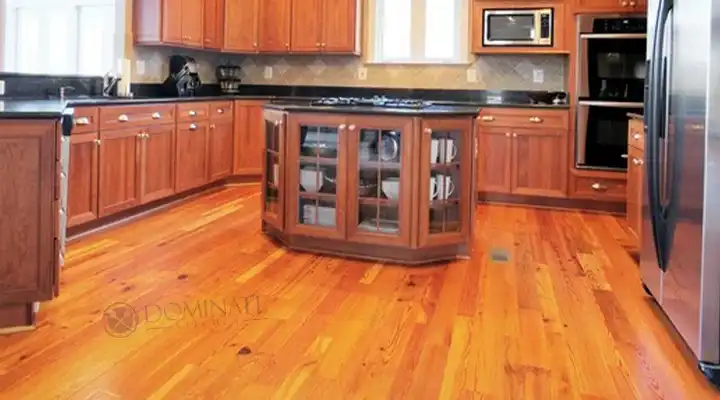Can You Have Laminate Flooring In A Kitchen? Let’s Find Out
As someone who loves home improvement and is always on the lookout for budget-friendly solutions, I’ve often wondered if laminate flooring is a viable option for the kitchen. After all, the kitchen is the heart of the home, and it endures daily wear and tear.
The good news is that yes, you can have laminate flooring in a kitchen. In fact, it is a popular choice for kitchens because it is durable, water-resistant, and easy to clean. However, it is important to choose laminate flooring that is specifically designed for kitchens. This type of flooring will have a higher wear rating and will be able to withstand the moisture and heat that is common in kitchens.
To settle the debate once and for all, I’m taking you into the world of laminate flooring to explore whether it’s a suitable choice for the kitchen hub.

Is It Possible To Have Laminate Flooring In The Kitchen?
The answer is a resounding “yes.” While there are some considerations and precautions to take, laminate flooring can indeed be a practical choice for your kitchen. With the right type of laminate, careful installation, and proper maintenance, it can offer an affordable and attractive flooring solution that stands up to the demands of this bustling space.
Basic Introduction to Laminate Flooring
Laminate flooring has gained immense popularity for its ability to mimic the look of hardwood, stone, or tile, all while being budget-friendly. This versatile flooring is constructed using high-density fiberboard or synthetic materials, topped with a high-definition printed layer that replicates the desired style, and then finished with a clear protective layer. It offers a wide range of colors and styles, from contemporary to traditional.
Pros and Cons of Having Laminate Flooring in the Kitchen
Before we decide if laminate flooring is a kitchen-worthy option, let’s take a closer look at its pros and cons.
Pros of Laminate Flooring
Variety
Laminate flooring provides an array of colors, thicknesses, and grades, enabling you to find the perfect finish that suits your style and complements your kitchen decor.
Affordability
One of the standout advantages of laminate flooring is its cost-effectiveness. It’s more budget-friendly per square meter compared to traditional wood flooring, making it an excellent choice for those looking to achieve a high-end aesthetic without breaking the bank.
Ease of Cleaning
Maintaining laminate flooring is a breeze. A quick sweep or vacuum removes dirt, and for deeper cleaning, a damp mop will have your floor looking as good as new.
Durability
Most modern laminate flooring is scratch-resistant, which makes it a practical solution for households with pets, children, or those who spend a lot of time in the kitchen.
Heat Resistance
Laminate flooring boasts superior heat resistance, especially when compared to wood. It can be installed over heating systems and is well-suited for humid conditions. Plus, it won’t feel uncomfortably cold underfoot, making it ideal for families with young children.
Easy Installation
Perhaps one of the best features of laminate flooring is its ease of installation. The “click” system, with pre-designed grooves, eliminates the need for glue, allowing you to take on the installation as a DIY project and save on installation costs.
Cons of Laminate Flooring
Appearance
While laminate flooring comes remarkably close to replicating the look of real wood, tile, or stone, upon close inspection, it’s evident that it lacks the depth and character of genuine materials. If you spend a lot of time in your kitchen with family and friends, this distinction may become noticeable.
Water Resistance
Historically, laminate flooring was considered unsuitable for wet rooms due to its vulnerability to moisture. While it’s now deemed suitable for kitchens, you must clean up liquid spills promptly to avoid moisture damage. Excessive water during cleaning should also be avoided.
Durability
Although well-maintained laminate can last around a decade, it is prone to tears, damage, and gouging, often caused by heavy furniture or pets. Unfortunately, it cannot be sanded or repaired, necessitating a full replacement in case of substantial damage.
What to Consider While Having Laminate Flooring?
If you’re committed to having laminate flooring in your kitchen, there are some crucial factors to keep in mind. To minimize potential issues, choose a highly water-resistant laminate floor and ensure that the seams between planks are tightly fitted during installation. These steps are essential in preventing moisture from penetrating the core of the laminate, which contains wood composite materials. Additionally, sealing the joints with silicon sealer can enhance water resistance. Proper installation and maintenance are key to preventing water damage.
Is There Any Alternative to Laminate Flooring?
While laminate flooring is a viable option, there are alternatives to consider. Vinyl and luxury vinyl tile flooring are both resilient choices for the kitchen. They offer excellent water resistance and durability, making them suitable for this space. Each option has its own set of pros and cons, so it’s essential to evaluate your preferences and needs before making a decision.
Conclusion
Ultimately, the debate over whether you can have laminate flooring in the kitchen has a clear answer: yes, you can. The numerous advantages, such as affordability, ease of maintenance, and durability, make laminate flooring a practical choice. However, it’s crucial to choose high-quality, water-resistant laminate and ensure meticulous installation to prevent moisture-related issues. For those who remain concerned about potential moisture damage, it’s worth considering laminate flooring options specifically designed to withstand water exposure. These can offer extra peace of mind.
Ultimately, the decision depends on your specific needs and preferences. With proper care, laminate flooring can serve as an attractive and budget-friendly solution for your kitchen, allowing you to enjoy a beautiful and functional space for years to come.






